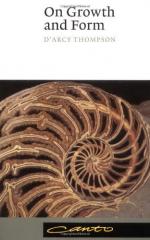|
This section contains 250 words (approx. 1 page at 400 words per page) |

|
On Growth and Form Summary & Study Guide Description
On Growth and Form Summary & Study Guide includes comprehensive information and analysis to help you understand the book. This study guide contains the following sections:
This detailed literature summary also contains Bibliography on On Growth and Form by D'Arcy Wentworth Thompson.
On Growth and Form, first published in 1917 and then republished in 1942 by Cambridge University Press, is D'Arcy Thompson's radical departure from standard zoology. Looking outside the scope of comparative morphology and evolution, he sought to study nature from a mathematical perspective. He looked to both ancient as well as modern texts to pull together his observations on the development of form and structure in living things. The resulting text is a poetic treatise dedicated to the wonders of nature.
What makes his observations so rich is his careful consideration and blending of philosophy, literature, and mathematical principle. The reader may hope to encounter the philosophy of Goethe or Hegel or perhaps the mention of Darwin (who was a personal acquaintance of Thompson's) or Galileo, among others. But what makes the text so remarkable is the melding or blending of the literary and the mathematical. In addition to being a brilliant mathematician and scientist, Thompson was a thoughtful teacher. When discussing the relationship of a sphere to its volume, for example, Thompson looks to Swift's character Gulliver and to the everyday world to illuminate his ideas.
What shines through and adds value to the work as a whole is the author's love of and deep respect for nature and the pursuit of knowledge. As a zoologist, scientist, and philosopher, Thompson leaves very little to chance in his rich and multifaceted approach to biological study, exploring the concepts of growth and form with objectivity that is persuasive to any audience.
Read more from the Study Guide
|
This section contains 250 words (approx. 1 page at 400 words per page) |

|



